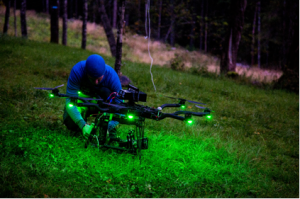Wild Electronics in Norwegian Nature

How can art—specifically art created by electronic elements of light and sound—enhance a natural environment? How can man-made creations become part of a landscape in such a way that honours and interacts with the inherent beauty of that landscape? How can a symbiotic relationship between a wild forest and wild electronics generate an alternative and engulfing multi-sensory experience for viewers, transforming the forest into a stage while at the same time transforming wires and light diodes into components of the natural world in which they are placed?
Questions like these were the inspiration for a recent installation created by a group of international artists in a woodland area in Norway. The area, called Dølerud, was a clearing in an old smallholding, which has a rich folkloric history dating back to the 17th century. It is a region that was home to Scandinavian beliefs about ancient supernatural creatures, such as trolls, and today enjoys protection under Norwegian law with the designation of a “fairytale forest.” The clearing is accessed via a narrow winding path through a thick wood, passing a shimmering lake along the way. It is a magical and mysterious spot, perfect for the artists’ investigation of their chosen themes.
The mediums of light and sound and electronics were familiar to all the artists involved, each of them coming from a unique background of working with electronics in different artistic settings. Melissa Larsen of Norway says she always had a fascination for wires and electronics and this has come to bear in her work with light play and combining light installations with music. She loves working with special software and hardware to create mesmerizing light shows. Hailing from Portugal, Joao Pereira has a similar passion for light play, in addition to working as an organizer and performer in some of the largest music and arts festivals in Scandinavia, including Øya, Insomnia, Roskilde, and Solar Weekend. Andy Cross is from the UK and brings more than 30 years of experience in music production and live performance to the table, including having founded Studio Two performance academies (now Studio Industries) in 2010, where all three artists previously worked together. This trio was assisted by Mich Rivera from Spain, Rasmus Stride of Denmark, and Piotr Tuszewicki and Kamil Modrzejewski from Poland.
The concept behind the installation, which was commissioned as part of a campaign for the new product Kvikk Lunsj Mørk by the Norwegian chocolate company Freia, was to invite viewers into an alternative nature experience, reinterpreting the popular Norwegian pastime of hiking and enjoying the great outdoors in the unusual context of nighttime. Darkness was the artists’ canvas and they painted, so the speak, with lights. Various custom designed light elements were rigged along the path to the Dølerud clearing, some of them motion-sensitive so that they were activated by the participants passing by. Some of the elements included “The Path of Light,” which illuminated the 1500 meter trail to the clearing; “Glow Shrooms,” internally radiant mushrooms; “Meadow of Light”; “The Balls,” bright spherical shapes scattered over the undergrowth of the forest; and “Mystery of Light.” In the end, there were up to 45,000 LED diodes in use and 2000 meters of wire and cable, in addition to all the technical equipment that made the running of the installation possible.
One of the greatest challenges of the project was indeed operating all the technical equipment and rigging the installation in the chaos of the natural environment. In contrast to urban settings, where the environment remains more or less stable, in the forest there is always a constant process of growth, decay, and change that makes the situation inherently unstable. While this may have been a challenge, it was also a crucial aspect to the project as a whole because it defined the way the artists approached their work and forced them to be adaptable and willing to make constant updates. But just because the short daylight hours in which the entire installation was rigged were harrowing and demanding doesn’t mean they weren’t also filled with fun. Getting into the groove and working in an adaptable organic way was what imbued the final result of the project with so much success.
ADVERTISEMENT

